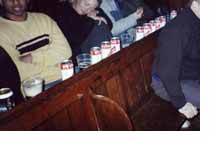
January 2002
Church without commitment
Previous Small Fires
 THE CHURCH SMELLS of weed. There are a thousand in here, average age around 30, cans of Red Stripe lined up along the pews in place of hymnbooks. The two video projectors and slide projector are pretty standard fare for big evangelical worship these days.
THE CHURCH SMELLS of weed. There are a thousand in here, average age around 30, cans of Red Stripe lined up along the pews in place of hymnbooks. The two video projectors and slide projector are pretty standard fare for big evangelical worship these days.The mixing desks in the balcony sport a row of open iBooks, old and new styles. There are a few candles. The audience chatter as they await the arrival of the choir, even while the guy with the beard and hoodie plays keyboard and sings soft and high into a microphone.
Then the choir and musicians troop onstage, dressed in formal purple. The audience hush. The choir sing a low harmony which gradually rises in intensity and volume until the sound fills the whole building. Subsequent songs play with the chapel acoustic in this way, augmented by an itinerant saxophonist moving through the audience. There are even a few alleluias.
 The works have been composed especially for this space, its volume and echo. Their idiom takes choral singing into ambient or minimalist territory, emphasising a continuous flowing wave of sound over words or melody. The punters are ecstatic.
The works have been composed especially for this space, its volume and echo. Their idiom takes choral singing into ambient or minimalist territory, emphasising a continuous flowing wave of sound over words or melody. The punters are ecstatic.
Then it's over. The DJ indulges his questionable sense of humour with kitsch Christmas medleys. The bar has closed and it's time to leave, though nobody who has a beer is in a hurry. We haven't and are.
Church for hip thirtysomethings? Yes, in a way. This is the first night of the Big Chill Winter Festival, at the Union Chapel in Islington. The Big Chill describes itself as "a multimedia organisation that spans festivals, concerts and club events, online radio, and a record label. Cumulatively, it is a way of life dedicated to transforming the spirit of our times. While the world gets ever faster and more transfixed with novelty, the Big Chill is committed to the organic, the intimate and, above all, the human."
Founded in 1994 as a Sunday all-day club event in the Union Chapel, the Big Chill has grown into a sizeable organization best known for its laidback and intimate summer festivals, and its chillout compilation albums. But it isn't Christian. And yet it shares the aesthetics, the values and the worldview of many believers.
We at Grace are familiar with the albums, but the Big Chill festival proper is usually too close in time to Greenbelt for any of us to go. So we were mildly shaken to find them replicating alternative worship from the mid-90s.
Setting aside the shock thought that some churches might be doing this better – cleverer visuals, more meaning – what struck us was how well received the religious aspects were. To me there was nothing that radical about the musical repertoire, except in using a church choir in an ambient chillout idiom. Even this was reproducing live a sound one has heard many times on CD. Still, most church choirs could learn a lot from this.
We wondered if the churchiness was novel to the audience. Given the church attendance statistics it's possible that hardly anyone there had been to one in years - if ever. What seemed fairly routine to us experienced churchgoers seemed completely new to them. They may have had little exposure to classical choral music either.
Of course the spiritual content was unfocused, non-specific. No hardline Jesus stuff to break the warm fuzzies. Still, one almost wonders if church is now so unknown for our generation that it has impact again, provided it's not naff.
 UNFORTUNATELY THIS INITIAL aesthetic impact will be naff in most churches they may stumble into. What captures is richness, mystery, intensity, stillness. The opposite of normal, demystified, bright and shiny modern worship, in fact. Come and have a chat and singalong with nice smiling jolly people – no thank you. Tread quietly through glittering darkness among the devotees – yes please. We'd like to belong even though we don't believe.
UNFORTUNATELY THIS INITIAL aesthetic impact will be naff in most churches they may stumble into. What captures is richness, mystery, intensity, stillness. The opposite of normal, demystified, bright and shiny modern worship, in fact. Come and have a chat and singalong with nice smiling jolly people – no thank you. Tread quietly through glittering darkness among the devotees – yes please. We'd like to belong even though we don't believe.What if we marketed church as an aesthetic phenomenon? And then set up the kind of church experiences that non-Christians find appealing? Are we too eager to give them the Gospel content? Could we let them wallow a while in mere atmosphere, beer in hand? "A while" meaning, not "until half-way through the service", but for a month, a year. Or two.
Have we the faith, the patience? Can we scatter the clues without strings, watch them leave without getting clingy? Are we open, clearly and obviously open, to having a casual uncommitted audience for our worship? Will we let them shop without pressing them to buy? And if we charged £13.50 entry, would they think we had something worth paying to see?
Top | Bio | Columns | SOF Home
© Ship of Fools 2002